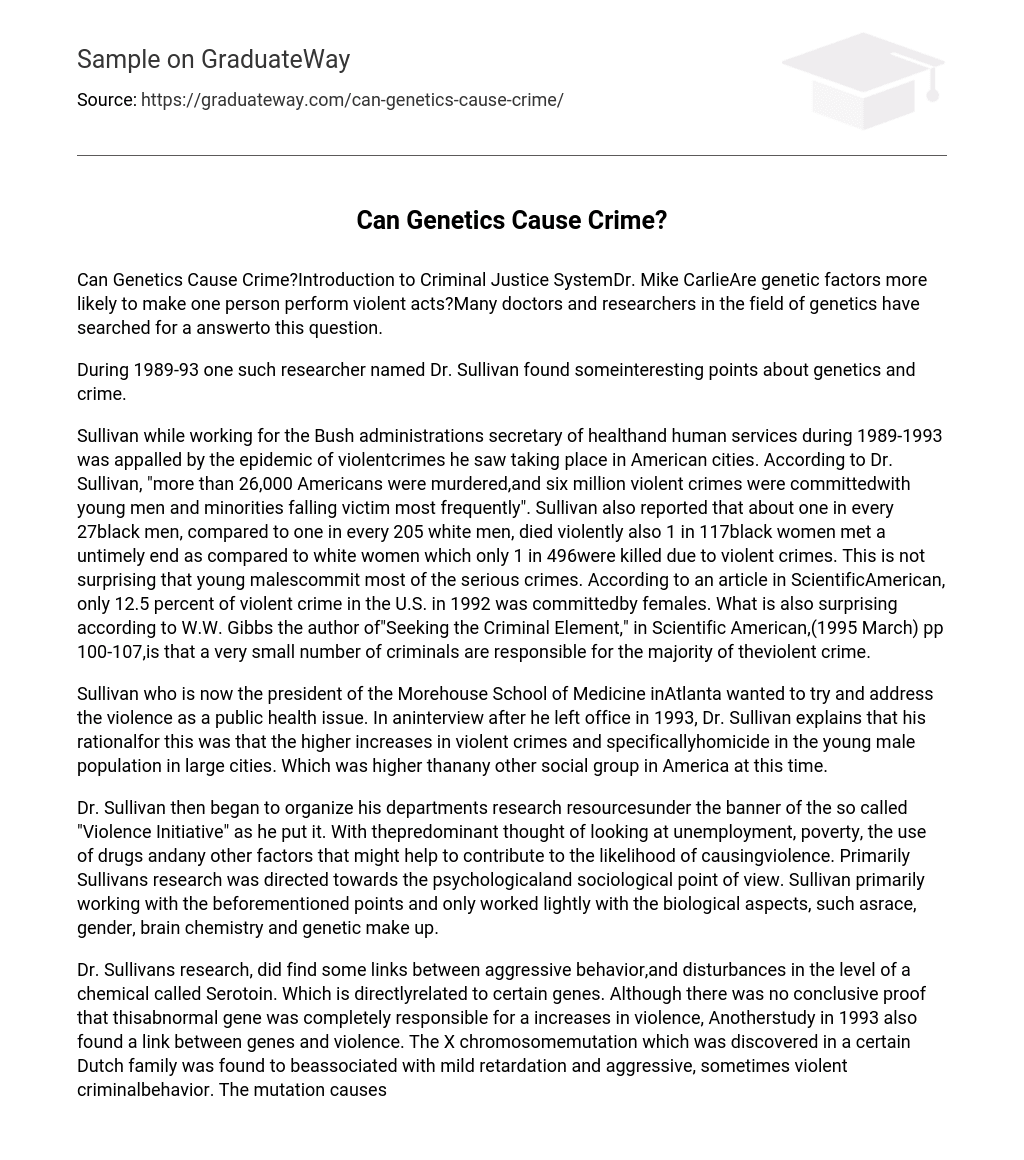Can Genetics Cause Crime?Introduction to Criminal Justice SystemDr. Mike CarlieAre genetic factors more likely to make one person perform violent acts?Many doctors and researchers in the field of genetics have searched for a answerto this question.
During 1989-93 one such researcher named Dr. Sullivan found someinteresting points about genetics and crime.
Sullivan while working for the Bush administrations secretary of healthand human services during 1989-1993 was appalled by the epidemic of violentcrimes he saw taking place in American cities. According to Dr. Sullivan, “more than 26,000 Americans were murdered,and six million violent crimes were committedwith young men and minorities falling victim most frequently”. Sullivan also reported that about one in every 27black men, compared to one in every 205 white men, died violently also 1 in 117black women met a untimely end as compared to white women which only 1 in 496were killed due to violent crimes. This is not surprising that young malescommit most of the serious crimes. According to an article in ScientificAmerican, only 12.5 percent of violent crime in the U.S. in 1992 was committedby females. What is also surprising according to W.W. Gibbs the author of”Seeking the Criminal Element,” in Scientific American,(1995 March) pp 100-107,is that a very small number of criminals are responsible for the majority of theviolent crime.
Sullivan who is now the president of the Morehouse School of Medicine inAtlanta wanted to try and address the violence as a public health issue. In aninterview after he left office in 1993, Dr. Sullivan explains that his rationalfor this was that the higher increases in violent crimes and specificallyhomicide in the young male population in large cities. Which was higher thanany other social group in America at this time.
Dr. Sullivan then began to organize his departments research resourcesunder the banner of the so called “Violence Initiative” as he put it. With thepredominant thought of looking at unemployment, poverty, the use of drugs andany other factors that might help to contribute to the likelihood of causingviolence. Primarily Sullivans research was directed towards the psychologicaland sociological point of view. Sullivan primarily working with the beforementioned points and only worked lightly with the biological aspects, such asrace, gender, brain chemistry and genetic make up.
Dr. Sullivans research, did find some links between aggressive behavior,and disturbances in the level of a chemical called Serotoin. Which is directlyrelated to certain genes. Although there was no conclusive proof that thisabnormal gene was completely responsible for a increases in violence, Anotherstudy in 1993 also found a link between genes and violence. The X chromosomemutation which was discovered in a certain Dutch family was found to beassociated with mild retardation and aggressive, sometimes violent criminalbehavior. The mutation causes complete deficiency of the enzyme monoamineoxidase also called (maoa), which metabolizes the neurotransmitters serotonin,dopamine, and noradrenaline.
According to David Goldman, a geneticist at the National Institute ofAlcoholism and Alcohol Abuse points out, “men who possess this abnormal gene may typically engage in impulsiveaggression, but the time, place, type, andseriousness of their crimes ( which includeexhibitionism, attempted rape, and arson) have been diverse and unpredictable.”Although these are examples of gene related violence, geneticinformation so far has been fairly unpredictable. Finding a defect such as themaoa mutation is an exceedingly rare event. Also according to Margret McCarthyof the University of Maryland School of Medicine, what matters in not whethersomeone possesses a gene, but whether that gene is expressed.
Although seems that genetics is unlikely to tell us much of practicalvalue about crime, other aspects of human biology may be more useful. AdrianRain of the University of Southern California at Los Angeles, showed cat scanscomparing brain activity in 42 murderers with that of an equal number of normalcontrols. The murderers tended to have less prefrontal activity, was consistentwith Raines Hypothesis that a damaged prefrontal cortex can lead to impulsiveaggressive behavior. But murderers, like the rest of us, are a heterogeneousgroup of people, Rain cautioned strongly against regarding such scans asdiagnostic. And that you cant do brain scanning on everyone and tell if theywill commit murder. In short applying this kind of research to crime controloften raises ethical and political issues and the same can be expected ofgenetic scanning and other aspects of biological research when its related tocontrolling crime.
It is possible that genetic research may eventually contribute somethingto our knowledge of crime, and perhaps even to its control. But thecontribution will most likely be indirect. And any aspects of genetic disordersor other biological factors, most likely will be contributed to other thingssuch as alcoholism and addictions rather than genes being blamed for the violentbehavior. Diana Fishbein, of the US Department of Justice states that,criminologists need to call for more research into behavioral disorders andattention disorders and certain other temperamental traits like impulstivitythat might be more likely to turn up better results in the fight against crime.
Sources CitedGidds W.W. (1995,March) “Seeking the Criminal Element,”Scientic American, pp 100-108.
Hallinan J. (1995, March 19th) “Prisons Becoming Major Industry,” the Huntsville Times, pp A19-20.
Internet Address Text: emailprotected, Genetics andCrime, By Wilson R.J. (1994),Science





